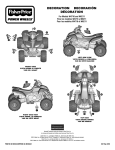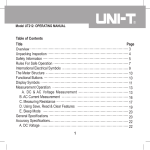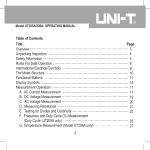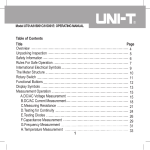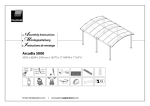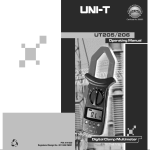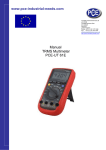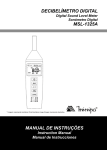Download UNI-T UT211 Specifications
Transcript
Model UT211: OPERATING MANUAL Table of Contents Title Overview Unpacking Inspection Safety Information Rules For Safe Operation International Electrical Symbols The Meter Structure Functional Buttons Display Symbols Measurement Operation A. DC & AC Voltage Measurement B. AC Current Measurement C. Measuring Resistance D. Frequency and Duty Cycle Measurement E. Operation of Hold Mode General Specifications Accuracy Specifications A. DC Voltage 1 Page 3 4 5 7 9 10 10 11 13 13 15 16 18 18 20 22 22 Model UT211: OPERATING MANUAL Title B. AC Voltage C. AC Current D. Resistance E. Frequency F. Duty Cycle Maintenance A. General Service B. Replacing the Battery Page 23 23 24 25 25 26 26 26 2 Model UT211: OPERATING MANUAL Overview This Operating Manual covers information on safety and cautions. Please read the relevant information carefully and observe all the Warnings and Notes strictly. Warning To avoid electric shock or personal injury, read the “Safety Information” and “Rules for Safety Operation” carefully before using the Meter. The Model UT211 (hereafter referred to as “the Meter”) are a 3999 counts 3 3/4 digits auto clamp multimeter, they auto sense on AC & DC voltage, AC current and resistance measurement. They have full range overload protection and special outlook design. They are such a smart electrical testing clamp meter. It equips also with frequency, duty cycle, low battery display and data hold features. 3 Model UT211: OPERATING MANUAL Unpacking Inspection Open the package case and take out the Meter. Check the following items carefully to see any missing or damaged part: Item 1 2 3 Description Qty Operating Manual Test Lead 9V Battery (NEDA 1604, 6F22 or 0006P) (installed inside the Meter) 1 piece 1 pair 1 piece In the event you find any missing or damage, please contact your dealer immediately. 4 Model UT211: OPERATING MANUAL Safety Information This Meter complies with the standards IEC61010: in pollution degree 2, overvoltage category (CAT. II 600V / CAT III 300V) and double insulation. CAT II: Local level, appliance, PORTABLE EQUIPMENT etc., with smaller transient voltage overvoltages than CAT. III CAT. III: Distribution level, fixed installation, with smaller transient overvoltages than CAT. IV. Under the influence of Radiated, Radio-Frequency Electromagnetic Field phenomenon, the UT211 may malfunction and can self-recover after the test. Use the Meter only as specified in this operating manual, otherwise the protection provided by the Meter may be impaired. In this manual, a Warning identifies conditions and actions that pose hazards to the user, or may damage the Meter or the equipment under test. 5 Model UT211: OPERATING MANUAL A Note identifies the information that user should pay attention on. International electrical symbols used on the Meter and in this Operating Manual are explained on page 9. 6 Model UT211: OPERATING MANUAL Rules For Safe Operation Warning To avoid possible electric shock or personal injury, and to avoid possible damage to the Meter or to the equipment under test, adhere to the following rules: Check for the lever is in good condition when measuring AC current. Must center the wire (conductor) within the transformer jaw. Before using the Meter inspect the case. Do not use the Meter if it is damaged or the case (or part of the case) is removed. Look for cracks or missing plastic. Pay attention to the insulation around the connectors. Inspect the test leads for damaged insulation or exposed metal. Check the test leads for continuity. Replace damaged test leads with identical model number or electrical specifications before using the Meter. Do not apply more than the rated voltage 600V, between the terminals or between any terminal and grounding. When the Meter working at an effective voltage over 60V in DC or 30V in AC, special care should be taken for there is danger of electric shock. When using the test leads, keep your fingers behind the finger guards. 7 Model UT211: OPERATING MANUAL Disconnect circuit power and discharge all high-voltage capacitors before testing resistance. Replace the battery as soon as the battery indicator appears or no display when turning on the Meter. With a low battery, the Meter might produce false readings that can lead to electric shock and personal injury. Before carrying out any measurement, make sure the Meter is in good condition after turning it on. When servicing the Meter, use only the same model number or identical electrical specifications replacement parts. The internal circuit of the Meter shall not be altered at will to avoid damage of the Meter and any accident. Soft cloth and mild detergent should be used to clean the surface of the Meter when servicing. No abrasive and solvent should be used to prevent the surface of the Meter from corrosion, damage and accident. Turn the Meter off when it is not in use and take out the battery when not using for a long time. Constantly check the battery as it may leak when it has been using for some time, replace the battery as soon as leaking appears. A leaking battery will damage the Meter. 8 Model UT211: OPERATING MANUAL Do not use or store the Meter in an environment of high temperature, humidity, explosive, inflammable and strong magnetic field. The performance of the Meter may deteriorate after dampened. International Electrical Symbols Deficiency of Built-In Battery AC or DC Grounding The allowed removable dangerous voltages existed between the leads. Conforms to Standards of European Union Warning. Refer to the Operating Manual Double Insulated 9 Model UT211: OPERATING MANUAL The Meter Structure (see figure 1) 1. Transformer Jaws designed to pick up the AC current flowing through the conductor. 2. LCD Display. 3. Function Buttons 4. Input Terminals 1 2 3 4 Functional Buttons Below table indicated for information about the functional button operations. (figure 1) Button Operation Performed Hz/% Press to select Frequency or Duty Cycle measurement mode. HOLD Press HOLD to enter the Hold mode in any mode Press to turn the Meter on and off. (POWER) 10 Model UT211: OPERATING MANUAL Display Symbols (see figure 2) (figure 2) Number Symbol Meaning 1 Hz / % Frequency and duty cycle measurement 2 HOLD Data hold is active. 3 “ Indicator for negative reading 4 AC Indicator for AC Voltage. 5 DC Indicator for DC Voltage “ 11 Model UT211: OPERATING MANUAL Number Symbol Meaning 6 OL Indicator for overloading 7 Auto The Meter is in the auto range mode in which the Meter automatically selects the range with the best resolution. The battery is low. Warning: To avoid false readings, which could lead to possible electric shock or personal injury, replace the battery as soon as the battery indicator appears. 8 9 ,k ,M Ohm. The unit of resistance. Kilohm. 1 x 103 or 1000 ohms. Mega ohm. 1 x 106 or 1,000,000 ohms. V Volts. The unit of voltage. A Indicator for AC current Hz Hertz. The unit of frequency. % Percent: Used for duty cycle measurements. 12 Model UT211: OPERATING MANUAL Measurement Operation The LCD displays full icon while turning on the Meter, then the Meter will enter to resistance testing mode, the LCD display “OL”. A. DC and AC Voltage Measurement (See figure 3) Warning To avoid harms to you or damages to the Meter from electric shock, please do not attempt to measure voltages higher than 600V although readings may be obtained. red When measure high voltages, take extra care to avoid electric shock. figure 3 13 black Model UT211: OPERATING MANUAL To measure DC and AC voltage, connect the Meter as follows: 1. Insert the red test lead into the V terminal and the black test lead into the COM terminal. 2.Connect the test leads across with the object being measured. When the AC voltage is higher than AC1.4V or DC voltage is higher than ±1.4V, the Meter will automatically enter the voltages measurement mode. The measured value shows on the display. Note Input Impedance is around 10M . When DC and AC voltage measurement has been completed, disconnect the connection between the testing leads and the circuit under test, and remove the testing leads away from the input terminals of the Meter. 14 Model UT211: OPERATING MANUAL B. AC Current Measurement (See figure 4) To measure current, do the following: 1.Check the lever is in good condition. 2. Press the lever to open the transformer jaws. 3. Center the conductor within the transformer jaw like figure 5 4. When the tested current is greater than AC0.4A, the Meter will automatically enter current testing mode. The measured value shows on the display, it is a effective value of sine wave (mean value response). correct incorrect N a Note b figure 4 When current measurement has been completed, disconnect the connection between the conductor under test and the jaw, and remove the conductor away from the transformer jaw of the Meter. 15 L Model UT211: OPERATING MANUAL C. Measuring Resistance (see figure 5) Warning To avoid damages to the Meter or to the devices under test, disconnect circuit power and discharge all the high-voltage capacitors before measuring resistance. red When the Meter working at an effective voltage over 60V in DC or 30V in AC, special care should be taken for there is danger of electric shock. figure 5 To measure resistance, connect the Meter as follows: 1. Insert the red test lead into the terminal and the black test lead into the COM terminal. 2. Connect the test leads across with the object being measured. The measured value shows on the display. 16 black Model UT211: OPERATING MANUAL Note The test leads can add 0.1 to 0.2 of error to resistance measurement. To obtain precision readings in low-resistance measurement, it is necessary to subtract the value measured when the testing leads are short circuited from the reading. If reading with shorted test leads is not less than 0.5 , check for loose test leads, incorrect function selection, or any other reasons. The LCD displays OL indicating open-circuit or the tested resistor or the resistor value is higher than the maximum range of the Meter. For high-resistance measurement (>1M ), it is normal to take several seconds to obtain a stable reading.. In order to obtain stable reading, try to use as short as test lead possible. When resistance measurement has been completed, disconnect the connection between the testing leads and the circuit under test, and remove the testing leads away from the input terminals of the Meter. 17 Model UT211: OPERATING MANUAL D. Frequency and Duty Cycle Measurement Frequency Measurement Press Hz% one time when measuring AC voltage, the LCD display will switch to frequency measurement mode from voltage measurement mode. Duty Cycle Measurement Press Hz% two times when measuring AC voltage or square wave voltage, the LCD display will switch to duty cycle measurement mode from voltage measurement mode. E. Operation of Hold Mode During current measurement Press HOLD when the Meter is under current measurement mode, the measured data will be hold. When the measuring signal is removed, the hold data remains unchanged. Press HOLD again, the hold data will be disappeared and the Meter automatically enters the resistance measurement mode. 18 Model UT211: OPERATING MANUAL During voltage, frequency and duty cycle measurement Press HOLD when the Meter is under voltage, frequency and duty cycle measurement mode, the measured data will be hold. When the measuring signal is removed, the hold data will be disappeared. The Meter automatically enters resistance measurement mode. Resistance measurement Press HOLD when the Meter is under resistance measurement mode, the measured data will be hold. When the measuring signal is removed, the hold data remains unchanged. Press HOLD again, the hold data will be disappeared. 19 Model UT211: OPERATING MANUAL General Specifications Maximum Voltage between any Terminals and Grounding: Maximum Current Measurement: of Transformer Jaw: Auto Function: Maximum Display: Overload Display: Range: Polarity Display: Measurement Speed: Below 1V/m electrostatic discharge: Over 1V/m electrostatic discharge: Temperature: Relative Humidity: Refer to different range input protection voltage. 400A. Auto detect Digital: 3999, 3 3/4 digits OL Auto Auto Updates 2-3 times/second. Accuracy = specified accuracy + 5% of the range. Without specified accuracy. Operating: 0 to +40 (32 to +104 ). Storage: -10 to +50 (14 to +122 ). 5% @ 0 to 30 ; 50% @ 30 to 40 . 20 Model UT211: OPERATING MANUAL Altitude: Battery Type: Battery Deficiency: Dimensions (HxWxL): Weight: Safety/Compliances: Operating: 2000 m. Storage: 10000 m. One piece of 9V (NEDA1604 or 6F22 or 006P). Display 210mm x 75.6mm x 30mm Approximate 300g (battery included). IEC61010 CAT. II 600V / CAT III 300V overvoltage and double insulation standard. Certifications: 21 Model UT211: OPERATING MANUAL Accuracy Specifications Accuracy: (a% reading + b digits) , guarantee for 1 year. Operating temperature: 23 5 . Relative humidity: 75%. A. DC Voltage Range Resolution Accuracy Overload Protection 4V 1mV 40V 10mV 400V 100mV (0.8%+1) Remarks Input impedance: Around 10M 600V Testing sensitivity: 60V 1V (1%+3) 22 DC 1.4V Model UT211: OPERATING MANUAL B. AC Voltage Range Resolution Accuracy Overload Protection 4V 1mV 40V 10mV 400V 100mV 600V 1V (1.2%+5) 600V (1.5%+5) Remarks Input impedance: Around 10M Displays effective value of sine wave (mean value response). Frequency response: 50Hz~400Hz. Testing sensitivity: AC1.4V C. AC Current Range Resolution 40A 10mA 400A 100mA Accuracy Remarks 0.4A input current 20A: (3.0%+8) >20A: (2.0%+8) 200A: (1.5%+5) >200A: (1.5%+50) 23 Frequency response 50Hz~60Hz. Display effective value of sine wave (mean value response). Testing sensitivity: AC0.4A Model UT211: OPERATING MANUAL D. Resistance Range Resolution Accuracy Overload Protection 400 0.1 4k 1 40k 10 400k 100 4M 1k (1.2%+2) 40M 10k (1.5%+2) (1.2%+2) + test lead short circuit resistance value (1.0%+2) 24 600Vp Model UT211: OPERATING MANUAL E. Frequency Range Resolution 1kHz 1Hz Accuracy (1%+3) Overload Protection 600Vp F. Duty Cycle Range Resolution Accuracy Overload Protection 99.9% 0.1% For reference only 600Vp 25 Model UT211: OPERATING MANUAL Maintenance This section provides basic maintenance information including battery replacement instruction. Warning Do not attempt to repair or service your Meter unless you are qualified to do so and have the relevant calibration, performance test, and service information. To avoid electrical shock or damage to the Meter, do not get water inside the case. A. General Service Periodically wipe the case with a damp cloth and mild detergent. Do not use abrasives or solvents. To clean the terminals with cotton bar with detergent, as dirt or moisture in the terminals can affect readings. Turn the Meter off when it is not in use. Take out the battery when it is not using for a long time. Do not use or store the Meter in a place of humidity, high temperature, explosive, inflammable and strong magnetic field. 26 Model UT211: OPERATING MANUAL B. Replacing the Battery (See figure 6) Warning To avoid false readings, which could lead to possible electric shock or personal injury, replace the battery as soon as the battery indicator “ ” appears or no display when turning on the Meter. serew battery Make sure the transformer jaw and the test leads are disconnected from the circuit being tested before opening the case bottom. figure 6 Make sure the test leads are removed from the input terminals. 27 Model UT211: OPERATING MANUAL To replace the battery: 1. Turn the meter power off and remove all the connections from the terminals. 2. Remove the screw from the battery compartment, and separate the battery compartment from the case bottom. 3. Remove the battery from the battery compartment. 4. Replace the battery with a new 9V battery (NEDA1604, 6F22 or 006P). Rejoin the case bottom and battery compartment, and reinstall the screw. ** END ** This operating manual is subject to change without notice. 28 Model UT211: OPERATING MANUAL 29 Model UT211: OPERATING MANUAL Copyright 2005 Uni-Trend Group Limited. All rights reserved. Manufacturer: Uni-Trend Technology (Dongguan) Limited Dong Fang Da Dao Bei Shan Dong Fang Industrial Development District Hu Men Town, Dongguan City Guang Dong Province China Postal Code: 523 925 Headquarters: Uni-Trend Group Limited Rm901, 9/F, Nanyang Plaza 57 Hung To Road Kwun Tong Kowloon, Hong Kong Tel: (852) 2950 9168 Fax: (852) 2950 9303 Email: [email protected] http://www.uni-trend.com 30






























